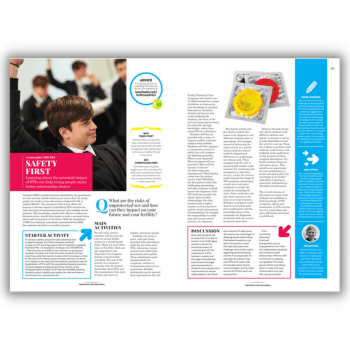Listen slowly, read quickly – Why staff communications should respect people’s time

Colin Foster argues that Macfarlane’s law may hold the key to crafting internal communication systems in schools that work better and faster for everyone…

- by Colin Foster

When in school, do you prefer to engage in a face-to-face chat or fire off an email? Do you happily attend oral ‘briefings’, or simply wish that the persons concerned would just write down whatever it is they want to say and send it to you, so you can skim through it much more quickly at a more convenient time?
Teachers and other busy school professionals often seem to be very dissatisfied with the modes of communication used within their schools. They tend to be fast-paced environments, what with all the bells ringing and people rushing around, so it’s essential that we’re as smart as we can be about how we manage our internal communications.
Tensions and frustrations
It turns out that many of the tensions and frustrations we experience with communication systems make a lot more sense when viewed from the perspective of Macfarlane’s law.
Like many grand-sounding laws, Macfarlane’s law seems obvious once you’ve heard it. It not only holds the key to understanding the issues that prevent communities from communicating, but can also provide a useful way of thinking about truly effective communication structures – how to design them, and how they can be made to work for distinct groups of people, such as the very busy professionals found in schools.
Macfarlane’s law sounds simple when stated. As the journalist and man himself, David Macfarlane, put it: “You can talk faster than you can type, but you can read faster than you can listen.”
Now, we’re not holding this to be an absolute truth for every person who’s ever lived, of course – people with dyslexia, for instance, will take a very different view – but it generally holds true for most of us, most of the time. And it can produce tension in situations where people need to communicate across power differentials, such as happens all the time in schools.
When communicating a message to someone, it will save the sender time if spoken, but save the recipient time if written. This may be one reason why, for example, a headteacher might prefer to convene a briefing where they can turn up relatively unprepared and speak their thoughts to the rest of the staff, who have no choice but to be there. Should any staff wish to respond to the points made, however, there’s a good chance that they may be expected to send an email.
Writing versus talking
I think we should resist the kind of system described above. It doesn’t represent good communication practice, is a poor model for students to see in operation, and is insufficiently respectful of people’s valuable time.
Standing up and speaking with minimal preparation to a large group is often a very poor use of everyone’s time. The audience has to filter out all the inevitable repetitions, false starts and pauses, and wait while the speaker figures out what exactly it is that they want to say.
To make this more concrete, let’s take an example. A 20-minute briefing may contain content which could, with perhaps 30 minutes of preparation, be summarised succinctly in an email that staff recipients can each read and digest inside of five minutes. This would allow people to hone in on the parts most relevant to them, while also providing a helpful reference source for those who unavoidably missed the briefing, or might wish to revisit the details.
The calculus is instructive here. The trade-off amounts to an extra 10 minutes (30 minutes minus 20 minutes) of the high-status person’s time, versus a saving of 15 minutes of everyone else’s time (I.e. 15 minutes multiplied by the number of people present). Even with a relatively modest staff of, say, 50, the traditional briefing model only makes sense if you perceive the headteacher’s time as being 26 times more valuable than the average staff member’s time.
Fit for purpose?
Of course, as everyone knows, the problem with relying on email is that people don’t always read it. Yet this is often for a good reason – because the emails in question aren’t worth reading! Before you’ve even finished reading yesterday’s email, there may well be a new one in your inbox today that corrects and updates it.
Another reason is that email messages can sometimes be hastily thrown together, complete with missing attachments, partial details or even gross errors. And then there’s the obvious fact that email recipients often won’t read emails because they simply don’t have the time – time which they otherwise would have, if they weren’t constantly having to rush from briefing to briefing.
This isn’t just an issue when it comes to whole- staff briefings. Similar considerations may come into play with respect to departmental meetings, tutor teams, and so on. If oral briefings are still your school’s default mode of message delivery, it’s worth asking why that is and how fit for purpose they are when viewed from the perspective of Macfarlane’s law.
The place for meetings
I’m not talking here about genuine meetings – occasions where people share ideas, ask questions and discuss things face to face. Depending on the topic, meetings such as these can be essential.
After all, no one wants to work in an organisation where everyone relentlessly pings emails to each other, even when personal and social encounters would be far preferable. Where we need to discuss sensitive issues or bounce ideas around, face-to-face encounters can’t be bettered.
But where one-way oral briefings are concerned, I think it often makes sense to replace them with carefully constructed emails, in a way that better respects everyone’s time.
Macfarlane’s law embodies an important truth about communication in the modern age. The facts are stark. People may speak around 150 words per minute, but read at over 200 words per minute. The fact that reading speed generally exceeds speaking speed is obvious whenever you watch a subtitled film. If the text is well-constructed, important information can be communicated far faster and with less ambiguity through text.
Teachers are probably among the most literate people in society, with well-honed skills at obtaining information efficiently from text, so why not make the most of that? Teachers talk for a living, and communication is at the heart of what we do. So let’s do it better, and save each other valuable time that can be better spent doing other things – or even on just taking a well-earned breather.
Colin Foster (@colinfoster77) is a Reader in Mathematics Education at the Mathematics Education Centre at Loughborough University. He has written many books and articles for mathematics teachers – find out more at foster77.co.uk











